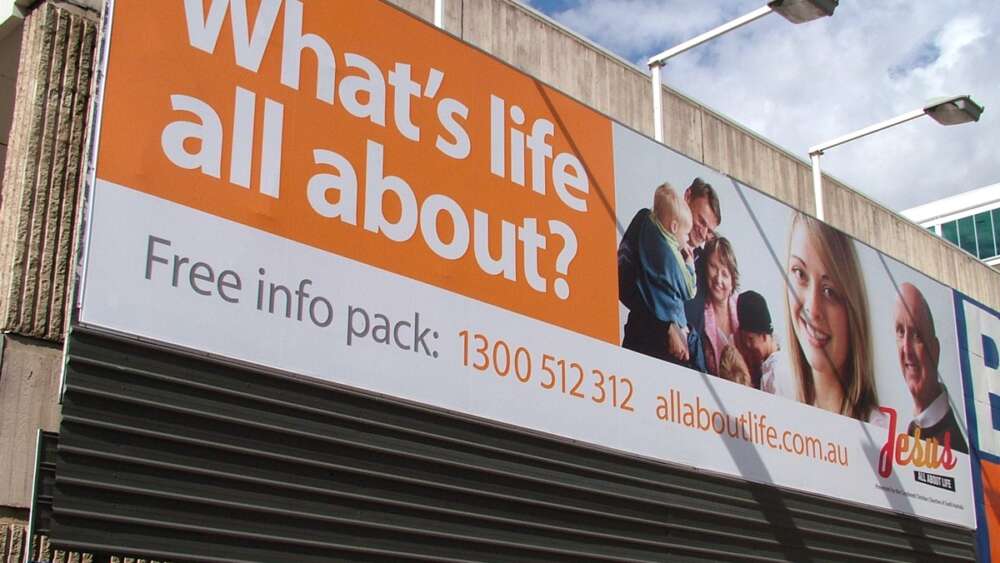The pioneering campaign that brought Jesus into people's homes
The product was Jesus, not the church
As Bible Society Australia gears up to relaunch the Jesus All About Life (JAAL) campaign in the lead-up to Easter this year, three people who helped steer the original pilot program in 2005 recall how the creation of a brand sparked a movement that brought Jesus into Australian homes.
The idea was seeded when a Christian foundation and a high-net-worth individual wondered what kind of gospel action could be mounted if the teachings of Jesus were presented in primetime mainstream media, with money no object.
As Karl Faase recalls, this led to a broad-based, innovative partnership between church leaders, local congregations, and Christian business people to bring the good news of Jesus’ to a whole city and train Christians to share their faith.
“This conversation happened before streaming and the internet and podcasting and all of that took off, so mainstream media – legacy media – was the media.”
““We felt that unless you had this tandem approach of mainstream media working alongside local churches, there’s a chance you’re going to basically waste your money.”- Karl Faase
Faase set up a think tank called the Christian Media Project, modelled on a campaign called Power to Change created by Campus Crusade for Christ in Canada, Ireland and South America, which adopted a logistical approach, strategic approach to using the media.
“If you just go out and do advertising, it can go nowhere. So the question is, if you’re going to spend a couple of million dollars in advertising, which is what happened, how do you know it’s going to do anything? Well, you’ve got to have local churches ready to respond to the advertising,” says Faase.
“We felt that unless you had this tandem approach of mainstream media working alongside local churches, there’s a chance you’re going to basically waste your money.”
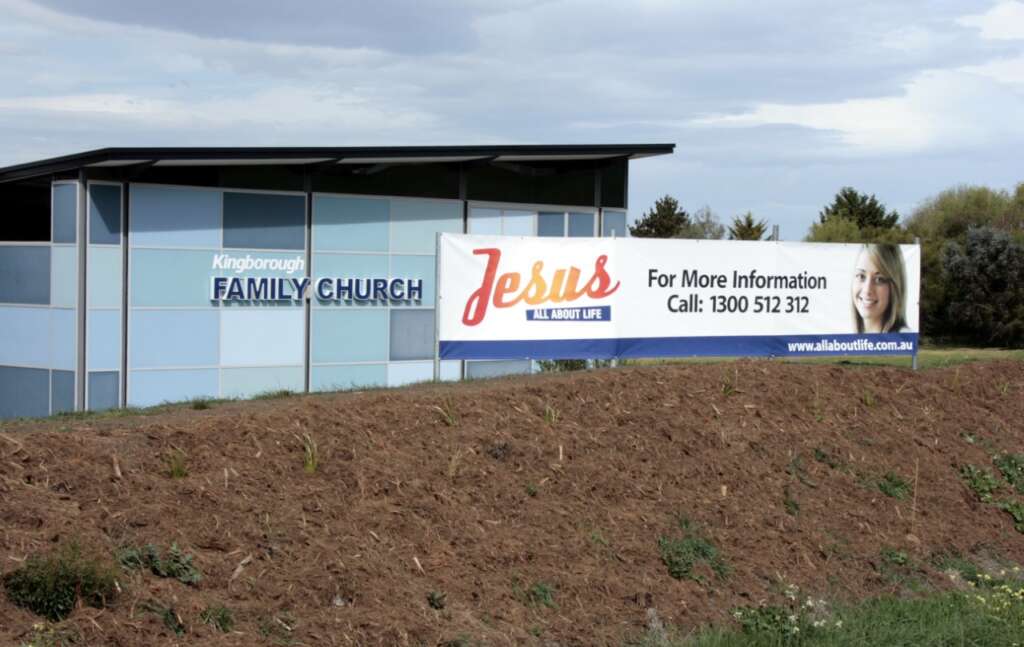
Tasmanian church sign for the 2007 campaign
Faase says his key role in getting JAAL off the ground was getting the churches on board, ready to respond at the grassroots to the advertising blitz with banners and events.
Faase believes this tandem approach was the key to the success and reach of the early campaigns in South Australia, Canberra and Tasmania, with mainstream media advertising working alongside local churches running courses and services, with material provided by Bible Society.
Having served for almost 20 years as senior pastor of Gymea Baptist Church in Sydney’s south, Faase well knows the unrelenting grind it can be to run a local church and how hard it is to maintain a mission focus.
“The challenge of running a local church is that you’re drowning in trivia. And the problem in doing that is most pastors are kind of swimming flat out and all they’re doing is keeping their head above water – they’re not actually getting anywhere very much,” says Faase, who is now the head of Olive Tree Media, through which he produces programs for Christian media and local church use internationally.
“The question is, how do you get mission on the agenda? How do you get evangelism on the forefront? And the point that most church leaders miss is, unless you really focus on it – in some periods of time, in some way – it’s never going to happen. That’s because nobody complains about it. People complain about the kids’ ministry. People complain about the music. No one ever complains that we’re not doing enough evangelism.”
“The strength of combined churches’ evangelistic endeavours is that it helps your average pastor think beyond themselves, but they don’t have to come up with everything themselves. You give them everything they need, all the collateral, so they don’t have to do a lot of work on it, and it doesn’t cost them money. All they have to do is get on board, pray, think it through and who knows what God will do with it?”
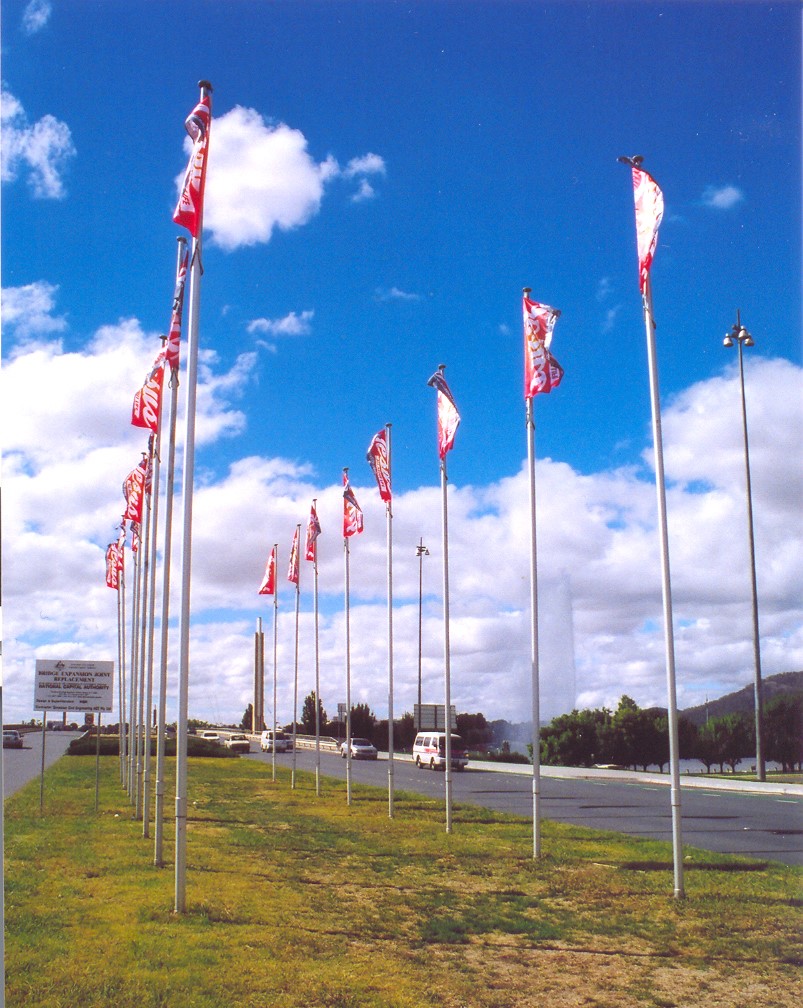
JAAL flags along Commonwealth Avenue, Canberra.
Bible Society in NSW under Daniel Willis came on board and employed TV producer Martin Johnson to work on the communications. Stuart Cameron, who was then the general secretary of the Uniting Church in Adelaide, agreed to chair the steering committee in Adelaide.
The remarkable aspect of this, in Faase’s mind, is that he successfully pitched the gospel project to Cameron and key South Australian church leaders before JAAL as an advertising model was developed.
“So they signed up to do this before they’d actually seen an ad,” he says.
Cameron, who is now CEO of Wesley Mission based in Sydney, recalls that he was able to engage the other heads of churches in the concept because there was and remains strong ecumenical cooperation across the breadth of churches in South Australia.
“So that helped and then we engaged Christian businesspeople to support this, which was a new thing in many respects in South Australia. They gave some significant financial support for the ad campaign, for example, and other programs and activities. So it was a partnership between denominational and para-church leaders, local congregations, and Christian business people then enabled that to happen.”
He said church leaders recognised that Christianity needed to engage in public places and engage with people where they are.
“This was before the proliferation of social media digital sort of platforms that we have now, but to engage in that media space was something we recognised as really important. It’s relatively easy to create Christian media ghettos where we’re speaking to ourselves rather than speaking to the broader culture and engaging in conversation, not just speaking to, but engaging people’s genuine questions in the broader culture.”
After the big-end donors in South Australia came on board, Faase approached a marketing guru called Angus Kinnaird, who called himself an agnostic, and asked him to research the most effective way to spend a lot of money promoting Christian faith within the mainstream media.
“The interesting thing he came up with is that the church’s profile within the community is not very good, but Jesus resonates with people. And so it was talking to Angus and Martin and the team where we developed Jesus All About Life.”
“The national organisation runs national TV campaigns, but people go to their local McDonald’s to get the product.” – Martin Johnson
The team wrote three ads informed by Kinnaird’s research which were shot in Melbourne.
“Essentially the key lines in the ads were ‘I’m not into religion, but I think what Jesus had to say is really important,’” Faase recalls.
Although churches were essential to the campaign, Martin Johnson explains that the main idea was to generate interest in Jesus rather than the church.
“We always said it was a bit like McDonald’s. The national organisation runs national TV campaigns, but people go to their local McDonald’s to get the product,” he says.
“And so we said that the key to this campaign’s success is getting local churches getting on board and having the Jesus All About Life banner outside their church. So people would see the campaign and they would then go to the local outlet, to use a marketing term, which was their local church. And so it really hinged on local churches doing as much as they could to leverage off the primetime media to then run something that reached out to their local area in their community.”
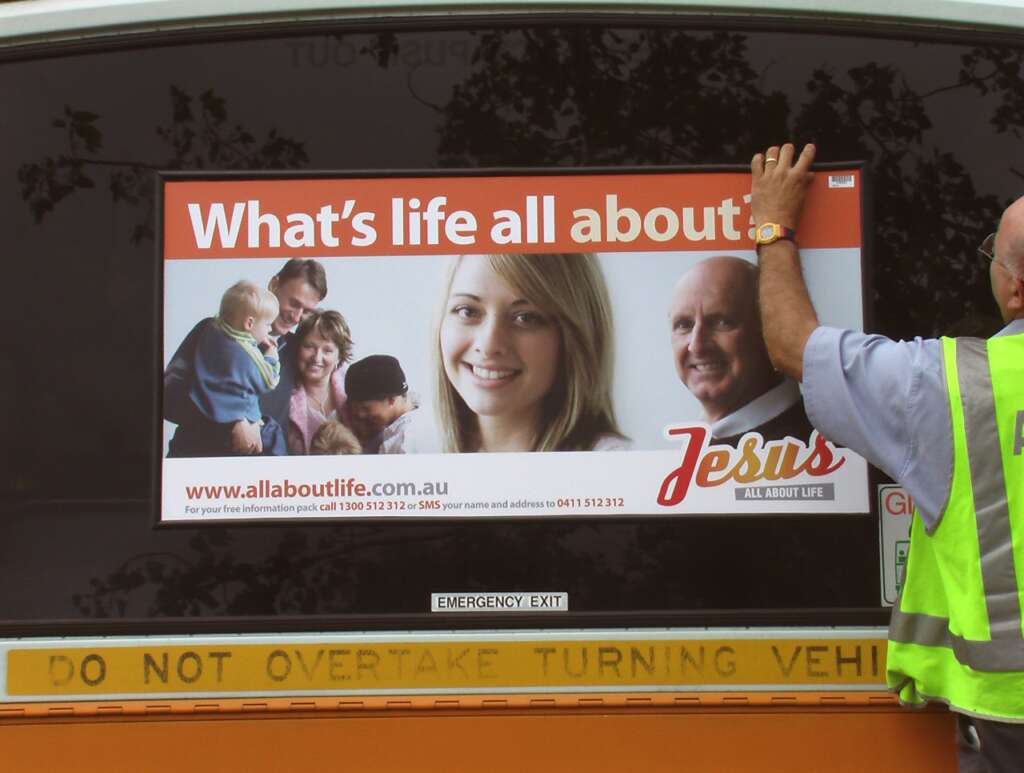
Back of a Canberra bus poster
The first campaign went to air in Adelaide between 8 August and 4 September 2005. During those five weeks, the television ads were shown 140 times and it was hoped they were seen 10 times by 90 per cent of the population. They were accompanied by radio and newspaper ads, 30 billboards, a mailout of 250,000 postcards, and a dedicated website. Some 299 churches in South Australia registered to take part, with 27 per cent outside the metropolitan area. Registered churches ran 558 events from August to December. In the leadup to the campaign, 6000 people were trained to share their faith and 75,000 people attended a JAAL event.
“It really hinged on local churches doing as much as they could to leverage off the primetime media to then run something that reached out to their local area in their community.” – Martin Johnson
The Canberra and region campaign built on the success of the Adelaide launch, beginning on 6 March and finishing after Easter in mid-April 2006. An estimated 22,000 people attended one of 275 events held by 161 churches and eight ministry organisations, with 4800 people trained to share their faith.
A Bible Society report noted that the real success of the campaign was in providing a stimulus for Christians to share the gospel with relatives, friends and workmates.
No comparable figures are available for the 2007 Tasmanian campaign but a report says JAAL events brought new people into church. However, feedback included that a particular church didn’t feel ready culturally to relate to non-Christians and another church leader felt they should have got church members excited about the campaign sooner.
Johnson says offshoots of the campaign included a meeting in Adelaide for blokes called Beer and the Bible and Andrew Fisher of Jesus Racing, who started visiting schools in NSW to run seminars on making wise life decisions. (He now uses the tagline Jesus – passion, purpose, life.)
“In South Australia, they actually wanted a Jesus All About Life course, like an Alpha course, so we shot and developed a Jesus All About Life six-week course, but that’s not been seen for a long time,” says Faase.
“If you do this advertising and they influence people to go to the local church, might that actually be a bad thing?” – Karl Faase
With all churches in a city or region displaying the same banners and branding, while bringing a local expression of the message, another byproduct was community surprise at this show of denominational unity.
“We got a lot of feedback where people were saying ‘I didn’t realise all these churches were on the same team’ – because you had all the different denominations all with the same message,” says Faase.
“The ads were fairly neutral in the sense that lots of people could sign up. There were a few questions. One of the things that people said was, are we controlling people [in churches] to put these signs up? What if we don’t like their theology? Well, it’s self-selecting, you know – if you can sign up to Jesus All About Life, as the ad says, knock yourself out.
“The other big discussion point is if you do this advertising and they influence people to go to the local church, might that actually be a bad thing? My response when people were saying that to me is, ‘Look, if you wait until every church was up to the standard that you would want, you’d never do anything.’”
Stu Cameron says it’s well documented that many people have no issue with Jesus but have a problem with the church.
“And since we rolled out the first Jesus All About Life campaigns, we’ve had royal commissions and other scandals that have plagued the church. So, if anything, the church’s reputation in the broader community has been diminished further. So that’s going to be a challenge for the [new] Bible Society campaign and it will require a particular posture to be able to manage that well,” he comments.
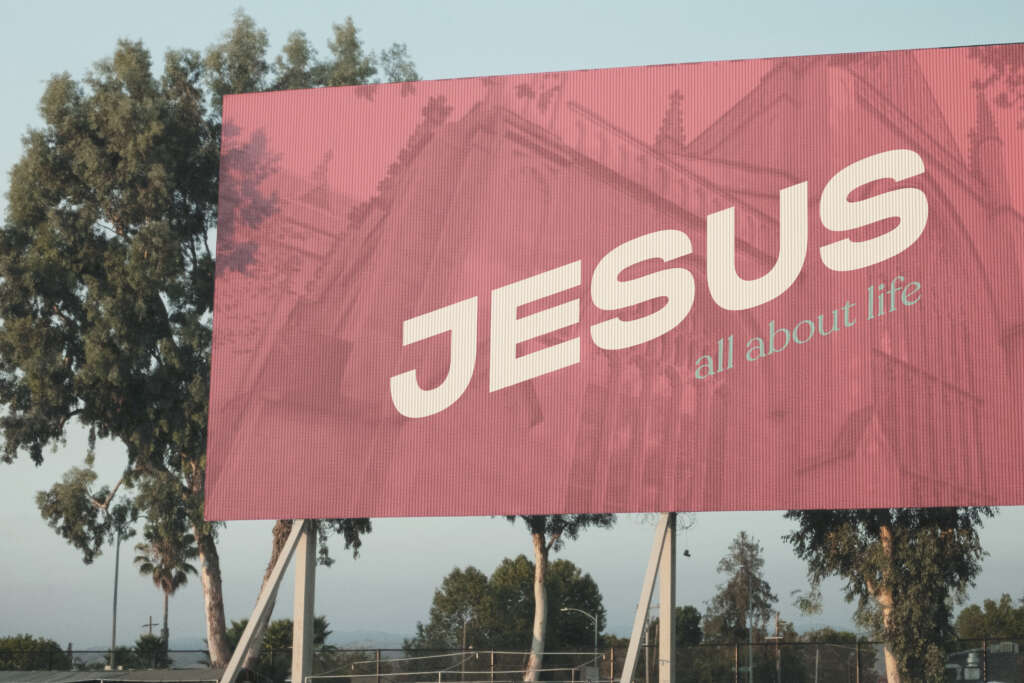
A mock-up of the new JAAL billboard
He sees a need to equip people with simple strategies to give them the confidence to engage in meaningful faith conversations that are not going to cause unnecessary offence.
“It wasn’t the primary purpose of Jesus All About Life, but I think one of the really good byproducts of it was that it actually engaged churches and congregations in a conversation about what does it mean to be genuinely hospitable and welcoming and a safe place for people to ask their genuine spiritual questions? And, whether we like it or not, many congregations don’t have those conversations as often as they should. And that will look different from different contexts, different times, different places,” he says.
He says the flexibility of the original campaign was a strength. “We weren’t trying to squeeze every church or leader into a narrow program or series of events. It really was an opportunity for churches and communities to be able to work out ‘What can we uniquely do? How do we engage our local community around these themes?’ So it was an empowering model rather than a constraining one.”
The initial JAAL campaign sparked a feature in The Australian newspaper, which called it the most broad-based campaign to arrest falling church attendance. And it was positively reviewed in an episode of ABC Television’s Gruen Transfer which looked at religious advertising.
“Most of the discussion was about Jesus All About Life. And I remember sitting there and watching it with my heart in my mouth thinking, ‘Oh gosh, what will they do?’” recalls Faase.
“But the interesting thing is, [presenter] Todd Sampson was actually quite positive about the advertising and he said something like this. ‘You know, the issue here is there’s not a problem with the product. There’s a problem with the retail outlets,’ which is essentially what Angus Kinnaird was saying. That’s what our research said right at the beginning.”
“In terms of people visiting churches, Howcroft also highlighted that is was a great success internally and publicly because it was funded by different denominations.”
Peter Bentley, then national director of the Assembly of Confessing Congregations, summed up Sampson’s point on its website this way:
“This research showed that ‘Church is bad – Jesus is cool.’ So they focused on their strength which is Jesus, but the advertising certainly won’t fix the problem that brand Christianity has. If you think of Christianity as a brand or a product, then its retail shops are the churches and most people would say the retail shops are letting the brand down … Todd Sampson went on to say ‘And probably the best re-branding of the shopping experience is done by Hillsong, I mean they’ve just dramatically changed the retail shop the church through theatre and music and they modernised it …’
“Russel Howcroft outlined a perceptive point that ‘They [the churches] are trying to normalise the idea of Jesus …. try and invite people to have a conversation they may otherwise feel uncomfortable to have…” and highlighted this campaign as being successful.” In terms of people visiting churches, Howcroft also highlighted that it was a great success internally and publicly because it was funded by different denominations. The panel noted this was a smart marketing job as well – reinforcing for ‘core users.'”
Email This Story
Why not send this to a friend?
